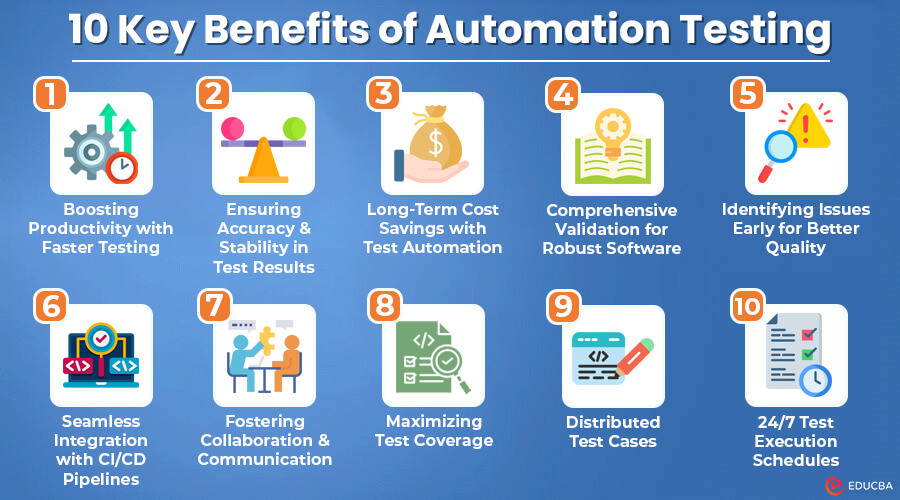
How Benefits of Automation Testing Drive Business Success?
Test automation is using software tools and scripts to perform testing tasks automatically rather than manually by a human tester. It ensures the application functions properly and quickly identifies any bugs or issues. Instead of manually checking each software feature, test automation allows tests to be run repeatedly, efficiently, and with less human effort. Let us view some crucial benefits of automation testing.
10 Key Benefits of Automation Testing
The test automation benefits are:
1. Boosting Productivity with Faster Testing
Automated tests run faster than manual tests, allowing teams to conduct tests more frequently and in less time. This speed is crucial in agile and DevOps environments, where short iterations and continuous delivery are common. Automating repetitive tasks lets testers focus on more complex and experimental testing, thereby improving overall efficiency.
2. Ensuring Accuracy and Stability in Test Results
Unlike manual testing, automated tests are rigorous and stick to the script as the test engineer decides. This consistency eliminates human error and ensures accurate results. In the early stages of software development, this stability helps developers identify defects, thereby improving the reliability and quality of the software.
3. Long-Term Cost Savings with Test Automation
While test automation requires initial investments in tools, training, and infrastructure, it reduces overall costs in the long run. Automated tests are more efficient and cost-effective as they decrease the need for intensive manual testing. Early detection of defects prevents them from entering the production phase, minimizing rework expenses and customer dissatisfaction. Automation also enhances scalability, allowing teams to handle more tests without increasing personnel or workload.
4. Comprehensive Validation for Robust Software
Automated testing provides greater test coverage compared to manual testing. Test scripts can cover various scenarios, edge cases, and interactions with other systems, ensuring comprehensive software validation. Increased test coverage reduces the risk of overlooking critical issues impacting business performance or user experience. It also helps meet regulatory requirements by regularly checking against specific standards in different settings and configurations.
5. Identifying Issues Early for Better Quality
Automated tests facilitate the early identification of bugs and issues during the software development lifecycle. Continuous testing allows teams to address problems as they arise, leading to higher returns on bug fixing. Early detection encourages collaboration between developers and testers, promoting quick issue resolution and enhancing software quality from within the teams.
6. Seamless Integration with CI/CD Pipelines
Test automation is fundamental to CI/CD pipelines, where updates and deployments are frequent. Automated tests verify each change to the codebase, ensuring that new features or updates do not introduce new issues or break existing functionality. Integrating testing into the CI/CD process allows teams to quickly address customer feedback and market needs, resulting in more frequent delivery of high-quality software.
7. Fostering Collaboration and Communication
Automated tests provide clear, uniform feedback for developers, testers, and other team members. By automating redundant validation tasks, teams can save time and focus on teamwork and problem-solving. The objective and repeatable nature of automated tests fosters confidence and communication among team members. This collaborative environment promotes continuous improvement and enhances the overall development process.
8. Maximizing Test Coverage
Manual testing cannot always provide quality test cases, and providing 100% coverage for any complex web application is challenging. However, automation testing tools make the testing process easier by ensuring that databases, web services, and user interfaces are all at par with the business requirements. Thus, they improve overall test coverage for web applications, which cannot be done effectively manually.
9. Distributed Test Cases
Distributing test cases over multiple OS, browsers, and machines is impossible through manual testing since testers can only perform one test on a single platform or device at a time. Automated testing tools distribute test execution to run simultaneously on multiple devices or platforms, thus improving efficiency. Manual testing across browsers causes multiple problems and challenges since testers need to identify the browser their application support. Manual cross-browser testing poses difficult challenges since customers use a wide range of browsers. Automated cross-browser testing tools, like the Lambda test, execute the same test cases multiple times on multiple browsers in parallel, thereby removing this problem.
10. 24/7 Test Execution Schedules
Automation testing can be performed anytime and anywhere. Automated tools can run nonstop 24/7 without needing physical rest, unlike human testers, who face restrictions based on time and geographical location.
Final Thoughts
Test automation is a transformative tool that offers software development teams improved reliability, quality, and productivity. Organizations can shorten testing timelines, reduce costs, and enhance software delivery by automating specific testing tasks. Test automation benefits include increased efficiency, consistent results, better coverage, early bug identification, and seamless integration with CI/CD systems. As technology advances, automating tests becomes essential for staying competitive and consistently delivering value to customers. Implementing automation tools and procedures allows managers to streamline testing operations, minimize risks, and ensure continuous improvement within software development teams.
Recommended Articles
This is a guide to the Benefits of Automation Testing. Here, we discuss the introduction and various benefits of automation testing. You can also go through our suggested articles to learn more –

